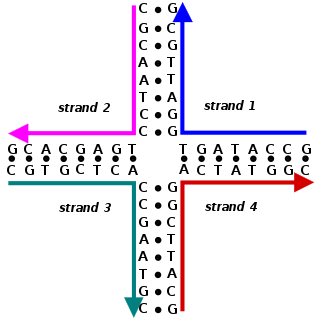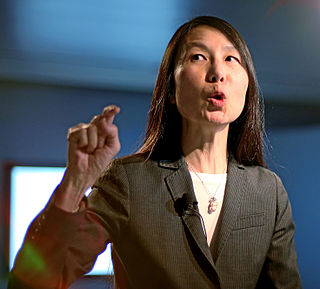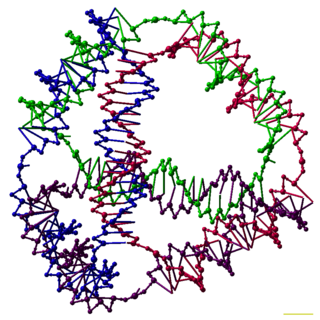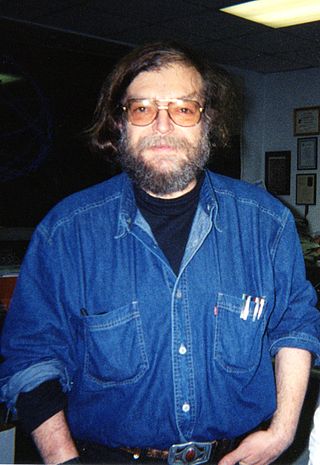Related Research Articles

DNA computing is an emerging branch of unconventional computing which uses DNA, biochemistry, and molecular biology hardware, instead of the traditional electronic computing. Research and development in this area concerns theory, experiments, and applications of DNA computing. Although the field originally started with the demonstration of a computing application by Len Adleman in 1994, it has now been expanded to several other avenues such as the development of storage technologies, nanoscale imaging modalities, synthetic controllers and reaction networks, etc.

Shlomi Dolev is a Rita Altura Trust Chair Professor in Computer Science at Ben-Gurion University of the Negev (BGU) and the head of the BGU Negev Hi-Tech Faculty Startup Accelerator.

DNA origami is the nanoscale folding of DNA to create arbitrary two- and three-dimensional shapes at the nanoscale. The specificity of the interactions between complementary base pairs make DNA a useful construction material, through design of its base sequences. DNA is a well-understood material that is suitable for creating scaffolds that hold other molecules in place or to create structures all on its own.
Paul Wilhelm Karl Rothemund is a research professor at the Computation and Neural Systems department at Caltech. He has become known in the fields of DNA nanotechnology and synthetic biology for his pioneering work with DNA origami. He shared both categories of the 2006 Feynman Prize in Nanotechnology with Erik Winfree for their work in creating DNA nanotubes, algorithmic molecular self-assembly of DNA tile structures, and their theoretical work on DNA computing. Rothemund is also a 2007 recipient of the MacArthur Fellowship.

A Holliday junction is a branched nucleic acid structure that contains four double-stranded arms joined. These arms may adopt one of several conformations depending on buffer salt concentrations and the sequence of nucleobases closest to the junction. The structure is named after Robin Holliday, the molecular biologist who proposed its existence in 1964.
Claire Jennifer Tomlin is a British researcher in hybrid systems, distributed and decentralized optimization and control theory and holds the Charles A. Desoer Chair at the University of California, at Berkeley.

Jeannette Marie Wing is Avanessians Director of the Data Science Institute at Columbia University, where she is also a professor of computer science. Until June 30, 2017, she was Corporate Vice President of Microsoft Research with oversight of its core research laboratories around the world and Microsoft Research Connections. Prior to 2013, she was the President's Professor of Computer Science at Carnegie Mellon University, Pittsburgh, Pennsylvania, United States. She also served as assistant director for Computer and Information Science and Engineering at the NSF from 2007 to 2010. She was appointed the Columbia University executive vice president for research in 2021.

Kurt Mehlhorn is a German theoretical computer scientist. He has been a vice president of the Max Planck Society and is director of the Max Planck Institute for Computer Science.

Nucleic acid design is the process of generating a set of nucleic acid base sequences that will associate into a desired conformation. Nucleic acid design is central to the fields of DNA nanotechnology and DNA computing. It is necessary because there are many possible sequences of nucleic acid strands that will fold into a given secondary structure, but many of these sequences will have undesired additional interactions which must be avoided. In addition, there are many tertiary structure considerations which affect the choice of a secondary structure for a given design.

Molecular models of DNA structures are representations of the molecular geometry and topology of deoxyribonucleic acid (DNA) molecules using one of several means, with the aim of simplifying and presenting the essential, physical and chemical, properties of DNA molecular structures either in vivo or in vitro. These representations include closely packed spheres made of plastic, metal wires for skeletal models, graphic computations and animations by computers, artistic rendering. Computer molecular models also allow animations and molecular dynamics simulations that are very important for understanding how DNA functions in vivo.

Grzegorz Rozenberg is a Polish and Dutch computer scientist.

DNA nanotechnology is the design and manufacture of artificial nucleic acid structures for technological uses. In this field, nucleic acids are used as non-biological engineering materials for nanotechnology rather than as the carriers of genetic information in living cells. Researchers in the field have created static structures such as two- and three-dimensional crystal lattices, nanotubes, polyhedra, and arbitrary shapes, and functional devices such as molecular machines and DNA computers. The field is beginning to be used as a tool to solve basic science problems in structural biology and biophysics, including applications in X-ray crystallography and nuclear magnetic resonance spectroscopy of proteins to determine structures. Potential applications in molecular scale electronics and nanomedicine are also being investigated.
Natural computing, also called natural computation, is a terminology introduced to encompass three classes of methods: 1) those that take inspiration from nature for the development of novel problem-solving techniques; 2) those that are based on the use of computers to synthesize natural phenomena; and 3) those that employ natural materials to compute. The main fields of research that compose these three branches are artificial neural networks, evolutionary algorithms, swarm intelligence, artificial immune systems, fractal geometry, artificial life, DNA computing, and quantum computing, among others.

Nadrian C. "Ned" Seeman was an American nanotechnologist and crystallographer known for inventing the field of DNA nanotechnology.
Quantum nanoscience is the basic research area at the intersection of nanoscale science and quantum science that creates the understanding to enable development of nanotechnologies. It uses quantum mechanics to explore and use coherent quantum effects in engineered nanostructures. This may eventually lead to the design of new types of nanodevices and nanoscopic scale materials where functionality and structure of quantum nanodevices are described through quantum phenomena such as superposition and entanglement. With the growing work toward realization of quantum computing, quantum has taken on new meaning that describes the effects at this scale. Current quantum refers to the quantum mechanical phenomena of superposition, entanglement and quantum coherence that are engineered instead of naturally-occurring phenomena.
The International Society for Nanoscale Science, Computation, and Engineering is a scientific society specializing in nanotechnology and DNA computing. It was started in 2004 by Nadrian Seeman, founder of the field of DNA nanotechnology. According to the society, its purpose is "to promote the study of the control of the arrangement of the atoms in matter, examine the principles that lead to such control, to develop tools and methods to increase such control, and to investigate the use of these principles for molecular computation, and for engineering on the finest possible scales."
Nataša Jonoska is a Macedonian mathematician and professor at the University of South Florida known for her work in DNA computing. Her research is about how biology performs computation, "in particular using formal models such as cellular or other finite types of automata, formal language theory symbolic dynamics, and topological graph theory to describe molecular computation".
Jacek Antoni Błażewicz is a Polish computer scientist specializing in the theory of algorithms and bioinformatics. He has been working as Director of the Institute of Computer Sciences of the Poznań University of Technology. He is also Head of the Department of Bioinformatics at the Institute of Bioorganic Chemistry of the Polish Academy of Sciences.
Hao Yan is a Chinese-American chemist, a (bio)molecular designer, programmer and engineer.
Lulu Qian is a Chinese-American biochemist who is a professor at the California Institute of Technology. Her research uses DNA-like molecules to build artificial machines.
References
- ↑ Erik Winfree resume
- ↑ Erik Winfree's homepage
- 1 2 Pelesko, John A. (2007). Self-assembly: the science of things that put themselves together. New York: Chapman & Hall/CRC. pp. 201, 242, 259. ISBN 978-1-58488-687-7.
- ↑ ""Biomolecular Computing" colloquium abstract". Archived from the original on 2017-01-08. Retrieved 2010-04-23.
- ↑ Technology Review's 1999 TR35
- ↑ Seeman, Nadrian C. (June 2004). "Nanotechnology and the double helix". Scientific American . 290 (6): 64–75. Bibcode:2004SciAm.290f..64S. doi:10.1038/scientificamerican0604-64. PMID 15195395.
- ↑ "1999 Young Innovators Under 35". Technology Review. 1999. Retrieved August 15, 2011.
- ↑ Erik Winfree's bio at Caltech Department of Computer Science Archived June 8, 2010, at the Wayback Machine
- ↑ Erik Winfree bio at Harvard